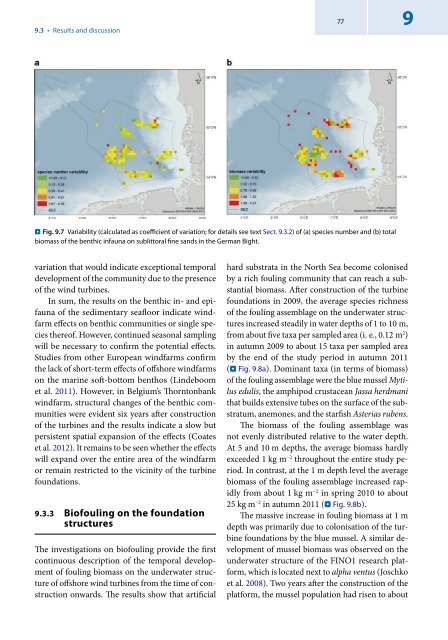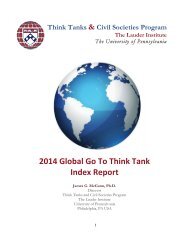bok%3A978-3-658-02462-8.pdf?auth66=1398409209_a0514c2b8e531c058ab8b810a0cad74d&ext=
bok%3A978-3-658-02462-8.pdf?auth66=1398409209_a0514c2b8e531c058ab8b810a0cad74d&ext=
bok%3A978-3-658-02462-8.pdf?auth66=1398409209_a0514c2b8e531c058ab8b810a0cad74d&ext=
- No tags were found...
You also want an ePaper? Increase the reach of your titles
YUMPU automatically turns print PDFs into web optimized ePapers that Google loves.
9.3 • Results and discussion77 9..Fig. 9.7 Variability (calculated as coefficient of variation; for details see text Sect. 9.3.2) of (a) species number and (b) totalbiomass of the benthic infauna on sublittoral fine sands in the German Bight.variation that would indicate exceptional temporaldevelopment of the community due to the presenceof the wind turbines.In sum, the results on the benthic in- and epifaunaof the sedimentary seafloor indicate windfarmeffects on benthic communities or single speciesthereof. However, continued seasonal samplingwill be necessary to confirm the potential effects.Studies from other European windfarms confirmthe lack of short-term effects of offshore windfarmson the marine soft-bottom benthos (Lindeboomet al. 2011). However, in Belgium’s Thorntonbankwindfarm, structural changes of the benthic communitieswere evident six years after constructionof the turbines and the results indicate a slow butpersistent spatial expansion of the effects (Coateset al. 2012). It remains to be seen whether the effectswill expand over the entire area of the windfarmor remain restricted to the vicinity of the turbinefoundations.9.3.3 Biofouling on the foundationstructuresThe investigations on biofouling provide the firstcontinuous description of the temporal developmentof fouling biomass on the underwater structureof offshore wind turbines from the time of constructiononwards. The results show that artificialhard substrata in the North Sea become colonisedby a rich fouling community that can reach a substantialbiomass. After construction of the turbinefoundations in 2009, the average species richnessof the fouling assemblage on the underwater structuresincreased steadily in water depths of 1 to 10 m,from about five taxa per sampled area (i. e., 0.12 m 2 )in autumn 2009 to about 15 taxa per sampled areaby the end of the study period in autumn 2011(. Fig. 9.8a). Dominant taxa (in terms of biomass)of the fouling assemblage were the blue mussel Mytilusedulis, the amphipod crustacean Jassa herdmanithat builds extensive tubes on the surface of the substratum,anemones, and the starfish Asterias rubens.The biomass of the fouling assemblage wasnot evenly distributed relative to the water depth.At 5 and 10 m depths, the average biomass hardlyexceeded 1 kg m −2 throughout the entire study period.In contrast, at the 1 m depth level the averagebiomass of the fouling assemblage increased rapidlyfrom about 1 kg m −2 in spring 2010 to about25 kg m −2 in autumn 2011 (. Fig. 9.8b).The massive increase in fouling biomass at 1 mdepth was primarily due to colonisation of the turbinefoundations by the blue mussel. A similar developmentof mussel biomass was observed on theunderwater structure of the FINO1 research platform,which is located next to alpha ventus (Joschkoet al. 2008). Two years after the construction of theplatform, the mussel population had risen to about




